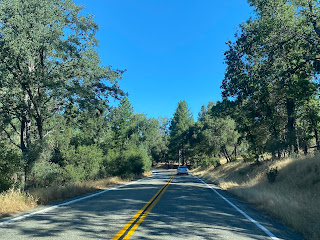Madera County Road 223 is an approximately six-mile-long rural highway which crosses Teaford Saddle in the Sierra Nevada range near Oakhurst. The corridor was a segment of the Gold Rush era Millerton-Fresno Flats Road which once served Fresno Flats (now Oakhurst) and the logging mills of Crane Valley. Prior to Madera County dropping roadway names the corridor was known as "Teaford Saddle Road."
Part 1; the history of Madera County Road 223
Madera County Road 223 was a segment of what was the Millerton-Fresno Flats Road. Fresno Flats (now Oakhurst) was settled in 1858 following the Mariposa War along the Fresno River. The community was originally centered around ranching and servicing the nearby mill operations in Crane Valley. The stage road eventually bypassed Millerton when the Fresno County seat was moved to Fresno in 1874.
The Fresno-Fresno Flats Road can be seen on the 1882 Bancroft's Map of California. The road can be seen crossing Teaford Saddle north of Fine Gold and entering Fresno Flat. An eastern fork in the road is shown serving travel to the mills of Crane Valley and the North Fork San Joaquin River (now North Fork Willow Creek).
As the automotive era in the twentieth century began the segments of the Fresno-Fresno Flats Road were assigned names. The segment over Teaford Saddle came to be known as Teaford Saddle Road. Said road spanned from Little Fine Gold Creek north to Crane Valley Road (now Road 406).
Teaford Saddle Road can be seen in detail on the 1912 United States Geological Survey Map of Mariposa. The road is shown to have been originally aligned through Tea Forks Ranch.
During the mid-twentieth century the road names of Madera County were dropped in favor of a numbering system. Teaford Saddle Road was subsequently reassigned as "Road 223." Road 223 appears on the 1953 United States Geological Survey Map of Bass Lake. The map displays road now bypassing Teaford Ranch and having a terminal elevation of 3,877 feet above sea level.
Part 2; a drive on Madera County Road 223
Northbound Road 223 begins via a left-hand turn from Road 221 near the community of North Fork.
Road 223 gently ascends to the top of Teaford Saddle. From the top of the saddle much of the lands of Sierra National Forest can be seen to the north.
The view facing west from Road 223 towards Oakhurst.
Road 223 descends from Teaford Saddle and terminates at Road 426. Westbound traffic can use Road 426 to access Oakhurst whereas eastbound traffic will reach the Bass Lake reservoir in Crane Valley.
























Comments